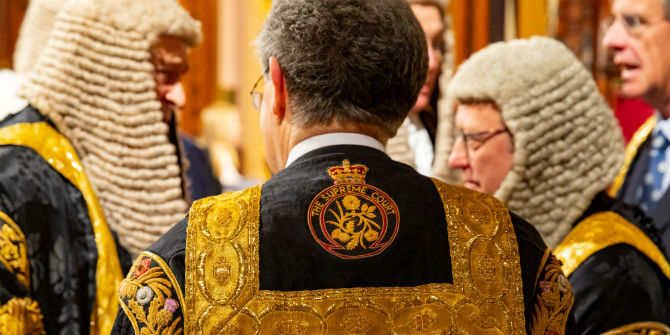The Withdrawal Agreement Bill includes a clause that gives ministers the power to make regulations with respect to the judicial treatment of retained EU case law after Brexit. James Lee (King’s College London) identifies four problems with this approach. The clause could easily be removed from the WAB with no impact on the government’s ability to ‘get Brexit done’.
The European Union (Withdrawal Agreement) Bill is the subject of scrutiny in the House of Lords this week, before returning to the Commons next week. The focus of this post is a new Clause, 26(1) of the Bill, which would have significant implications for the relationship between the government, Parliament and the courts. The government seeks ‘certainty and consistency in how law is applied’, and to provide for ‘courts [to] have comprehensive and clear … guidance on how to interpret this body of law’ (Delegated Powers Memorandum, para 366). I argue that the new clause is unusual and undesirable given the doctrine of precedent, the hierarchy of our courts and the separation of powers.

What does the relevant clause say?
The clause would amend section 6 of the European Union Withdrawal Act 2018 (’section 6’ hereafter). The existing section as enacted provides that courts are not to be bound by Court of Justice of the European Union (CJEU) decisions made on or after exit day, but may have regard to such decisions, so far as it was relevant to any matter before the court. However, existing EU law (‘retained EU law’) that is not otherwise changed by legislation would continue to be interpreted in accordance with retained case law. Thus, Parliament was to have the opportunity to legislate in respect of any specific decisions that were considered to be inconsistent with the post-Brexit vision of law, but there would otherwise be continuity. Only final courts of appeal – the UK Supreme Court for all matters within its jurisdiction and the High Court of Justiciary for criminal appeals from Scotland – can depart from retained case law, applying the same test to such decisions as they would to the question whether to depart from their own case law. The aim of these provisions was to provide continuity and certainty, given the major change involved in the UK’s departure from the EU.
The new clause instead proposes to confer upon a minister of the Crown a broad power to make regulations to provide for how the courts will approach retained EU case law (there is a non-exhaustive list of what the regulations may provide for). Significantly, those powers would enable a minister to make regulations for any court to be designated as a ‘relevant court’ for the purpose of not being bound by retained EU case law, to the extent provided by the regulations. The Memorandum lays out the apparent explanation for these powers (at para 365):
‘given that we are leaving the jurisdiction of the CJEU, it is right that UK courts should be able to decide to depart from the rulings of a Court whose jurisdiction, in most cases, is no longer relevant.’
But there is no explanation of why this power should be extended to courts that do not usually exercise a power to depart from previous authority.
Four problems
Final courts of appeal
The Supreme Court takes the approach that ‘while treating [its] former decisions … as normally binding, [it will] depart from a previous decision when it appears right to do so’. The Justices have been very reticent in exercise this power: ‘this Court should be very circumspect before accepting an invitation to [do so]’ (Knauer v Ministry of Justice [2016] UKSC 9, [23]). The High Court of Justiciary has a distinct approach to precedent, but still recognises the value of consistency. Thus, these courts exercise caution when entertaining challenges to existing decisions, and the same approach would be taken under the existing 2018 Act to CJEU decisions. The new clause would instead enable ministers to make regulations which would vary the test applied by these courts. Given the developed body of law governing precedent in these courts, the addition of other considerations would seem to point to the executive direction of a different test.
‘Relevant courts’
The new clause would allow for a radical change, capable of generating considerable uncertainty in daily litigation in the courts and tribunals up and down the country.
It is important to appreciate the pervasiveness of EU law as adopted into our law. A good example is the law on product liability: under the Consumer Protection Act 1987, which implements the Product Liability Directive 85/374/EEC, consumers injured by a defective product do not need to show ‘fault’. It does not appear that there has been any suggestion that this legislation will be repealed by the withdrawal agreement. So, as the law stands, if I go to Exeter County Court to sue the manufacturer of a defective toaster, I would rely on the interpretation of that legislation in existing English and CJEU decisions as relevant binding authorities.
There are therefore numerous problems with extending the power to depart from retained case law to lower courts. First, it engenders uncertainty. The lower courts operate within the system of precedent, and the doctrine not only means that courts take their own previous decisions seriously; it also relies upon the hierarchy of the courts, with lower courts following the decisions of superior courts (see eg Willers v Joyce (No 2) [2016] UKSC 44). First instance judges are not used to departing from authorities: if even courts of first instance are able to depart from retained case law, then every such existing authority may be up for debate and challenge. The prospect would add to the complexity and length of trials, and also cause uncertainty for litigants, consumers, business, employees, employers and the government, as outcomes would be unpredictable.
In the Committee debate in the Commons last week, the relevant minister, Robin Walker, committed the government to preserving ‘long-standing constitutional principles such as the structure and hierarchy of the court system’, (8 January 2020, vol 669 col 433). But the limited reasoning behind the clause does not seem to appreciate the challenges. How would it work? If a county court judge, or a panel sitting in the Upper Tribunal, decided to depart from a previous decision of the CJEU, would other courts (of differing levels of seniority) then be expected to treat that decision as no longer binding? Or would it still be for the relevant final court of appeal to confirm that the decision was no longer binding? This would be particularly complicated where higher courts have themselves previously applied the relevant CJEU case law. The existing Section 6 at least has the advantage of fitting with and respecting the hierarchy of courts within the United Kingdom.
This scheme would also place judges at the forefront of dealing with what will be politically controversial questions in otherwise routine cases. Unlike some critics (such as Richard Ekins), I do not say this out of a concern about judicial agendas or the need to minimise judicial power (and there is no indication that the courts have sought such a power). But rather, it is about the appropriate responsibility for identifying supposed problems and the scrutiny of decisions: the approach envisaged by cl 26(1) would involve an abdication of responsibility by the government and Parliament in tackling difficult and controversial questions, passing the buck instead to the courts.
Consultation obligations
The Memorandum states that the government recognises that this ‘is clearly a sensitive matter, and important for certainty and consistency in how law is applied. Therefore, the Government wishes to consult with the judiciary…’ (Memorandum, para 366). This wish would manifest as a duty, as before making any such regulations, the minister would be under a duty to consult numerous members of the senior judiciary. There would, though, be no requirement to give effect to the views of those consulted All ministers of the Crown have an obligation to uphold the continued independence of the judiciary under s 3(1) of the Constitutional Reform Act 2005. This duty would have to be complied with in the conduct of any consultation and process of making regulations. It is even questionable whether it would be appropriate for the judiciary to discuss the approach to precedent to be prescribed by regulations.
Any regulations may instead enable named members of the judiciary to determine the relevant considerations for deciding whether to depart from any retained case law, rather than a minister (Memorandum, para 360). This is said by the Memorandum to respect the ‘importance’ of the role for the judiciary but it is only one option open to the minister, so perhaps not all that important.
Timing
It is worth noting that there would be a narrow timeframe for any regulations under clause 26(1) to be made:
‘the intention is that any regulations made will be made during the implementation period, so that this guidance can be available to the courts when such questions of interpretation start to arise at the end of that period.’ (Memorandum, para 367).
(This contrasts with other provisions of the Bill allowing for regulations on other matters to be made up to two years after the end of the implementation period (eg clauses 3 and 4)). Yet insofar as there are existing CJEU decisions that are thought to be problematic, they could be addressed in the current Bill. If there are no such decisions that can be identified at this stage, then we may doubt the need for the power at all.
Conclusion
In conclusion, Clause 26(1) is a troubling and unnecessary inclusion in the Withdrawal Agreement Bill. It is unclear what specific problem it is designed to solve (no specific decisions are identified, for example), so ‘certainty and consistency’ are unlikely to be achieved. Instead, introducing this power, and any subsequent regulations, would encourage uncertainty and increase the risk of inconsistency, such that control would be lost rather than taken back (as the rhetoric has it). On the positive side, this need not be a partisan issue: this sub-clause could be omitted from the Bill without having any bearing on ‘getting Brexit done’. Even if the Bill is passed with the clause in its present form, the regulations should not be made.
This post represents the views of the author and not those of the Brexit blog, nor LSE.







Clause 26 (1) of the withdrawal agreement is quite clearly designed to resolve problems created by the ECJ’s politicism, perceived lack of impartiality, and to deal with it simply and quickly.
‘ECJ’s advocate general’s Opinion in Wightman and Others v Secretary of State for Exiting the European Union that Article 50 can be revoked unilaterally, in which the senior legal adviser conveniently ignored the court’s established case law that it does not consider hypothetical questions not arising from a genuine underlying legal dispute, provides a powerful reminder that this court will never be anything other than the legal machine for pursuit of EU integration.’
‘ECJ – an imperial, not an impartial, court’ The Law Society Law Gazette 06 Dec 2018
There will be plenty of time for more precision once this country has, finally, removed itself from a lamentably unreformed, imperial eu.